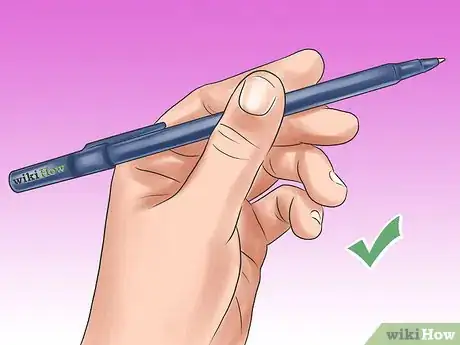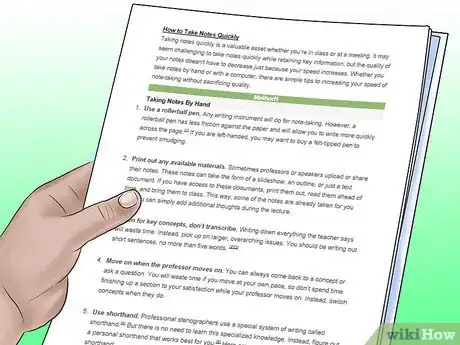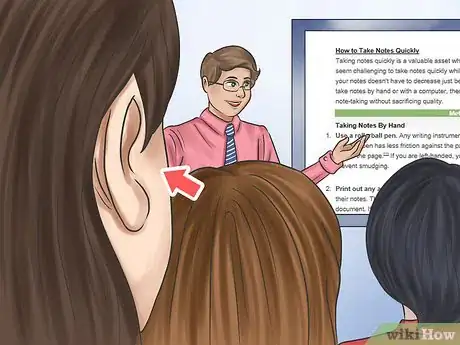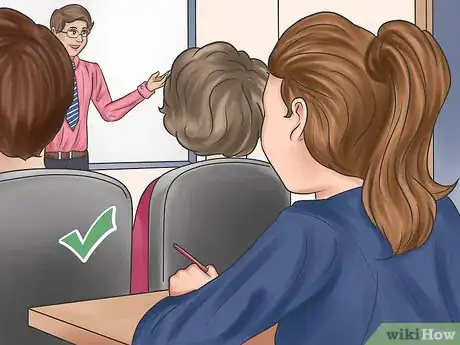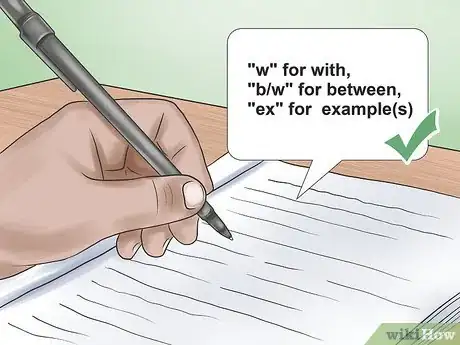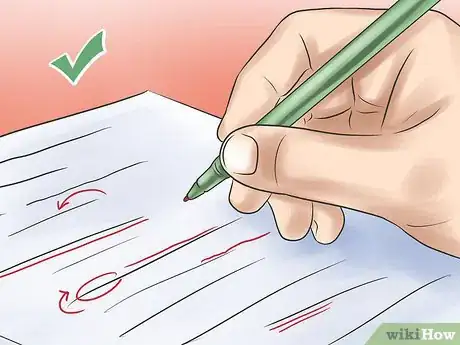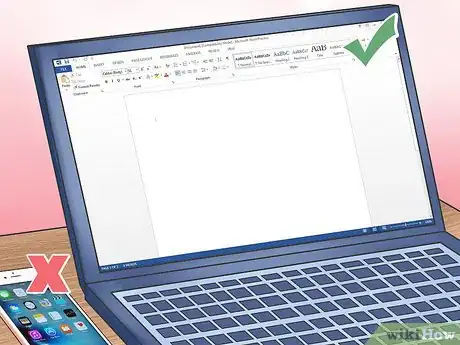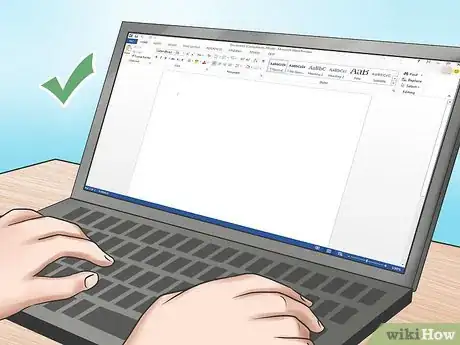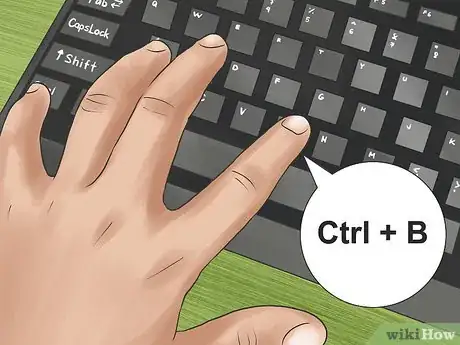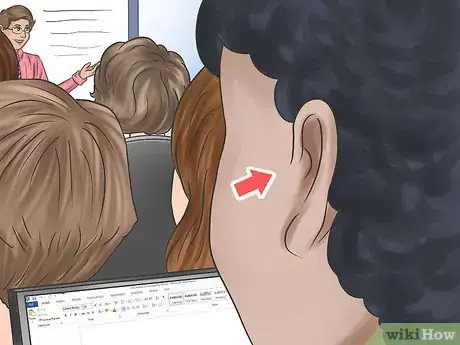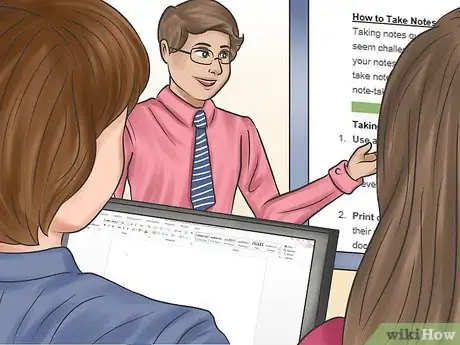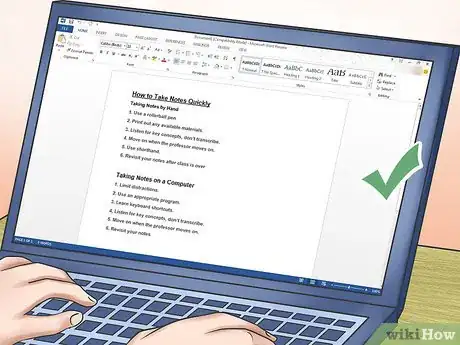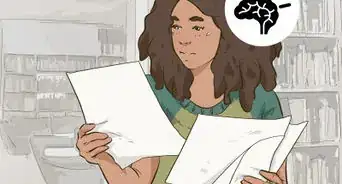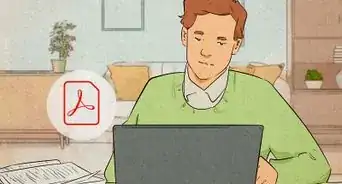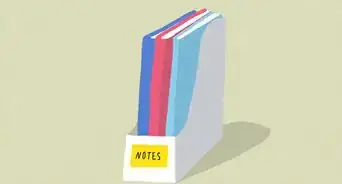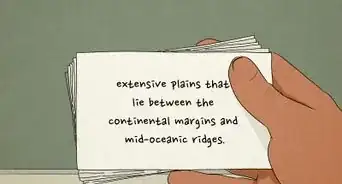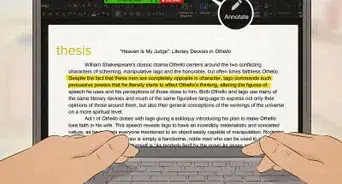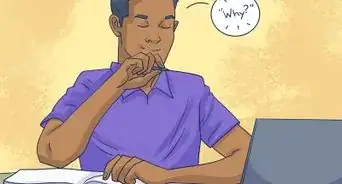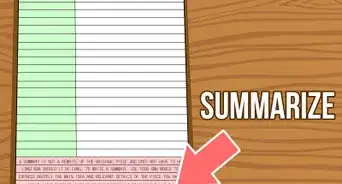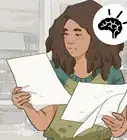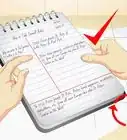This article was co-authored by Michelle Golden, PhD. Michelle Golden is an English teacher in Athens, Georgia. She received her MA in Language Arts Teacher Education in 2008 and received her PhD in English from Georgia State University in 2015.
There are 7 references cited in this article, which can be found at the bottom of the page.
wikiHow marks an article as reader-approved once it receives enough positive feedback. In this case, several readers have written to tell us that this article was helpful to them, earning it our reader-approved status.
This article has been viewed 148,442 times.
Taking notes quickly is a valuable asset whether you’re in class or at a meeting. It may seem challenging to take notes quickly while retaining key information, but the quality of your notes doesn't have to decrease just because your speed increases. There are simple tips to follow to increase your speed of note-taking without sacrificing quality.
Steps
Taking Notes By Hand
-
1Use a rollerball pen. Any writing instrument will do for note-taking. However, a rollerball pen has less friction against the paper and will allow you to write more quickly across the page. If you are left-handed, you may want to buy a felt-tipped pen to prevent smudging.
-
2Print out any available materials. Sometimes professors or speakers upload or share their notes. These notes can take the form of a slideshow, an outline, or just a text document. If you have access to these documents, print them out, read them ahead of time, and bring them to class. This way, some of the notes are already taken for you and you can simply add additional thoughts during the lecture.Advertisement
-
3Listen for key concepts, don’t transcribe. Writing down everything the teacher says will waste time. Instead, pick up on larger, overarching issues. You should be writing out short sentences, no more than five words.[1]
-
4Move on when the professor moves on. You can always come back to a concept or ask a question. You will waste time if you move at your own pace, so don’t spend time finishing up a section to your satisfaction while your professor moves on. Instead, switch concepts when they do.
-
5Use shorthand. Professional stenographers use a special system of writing called shorthand.[2] But there is no need to learn this specialized knowledge. Instead, figure out a personal shorthand that works best for you.[3] Here are some ways you can try shorthand:
- Use abbreviations for both proper nouns and long and tedious words. For example, write “US” for “United States,” but also "w" for "with," "b/w" for between, "ex" for "example(s)."
- Drop articles like “the,” “an,” and “a.”
- Drop vowels. For example, write “trnsfrmtn” instead of “transformation.”
- Use arrows and lines to convey relationships instead of cumbersome sentences. For example, instead of saying “the assassination of Archduke Franz Ferdinand IN 1914 caused World War I,” say, “ass. F Ferdinand → ww1 - 1914”
- Write in cursive. Like the gel pen, writing in cursive will shave off note-taking time because your pen never leaves the paper.
-
6Revisit your notes after class is over. Take a moment after the lecture or class and revisit your writing. This time is when the information will be freshest in your mind.[4] At this moment:[5]
- Add any information you were not able to write down.
- Look for sloppy handwriting and rewrite any illegible words while you still know what they mean.
- Pick up on larger overarching concepts that you missed in class.
Taking Notes on a Computer
-
1Limit distractions. You should only have one window open—the one you are taking notes in. Close all other windows and programs. Consider turning WiFi off. Put your phone away.
-
2Use an appropriate program. Pick a note-taking or word-processing program that works best for your needs.[6] For example, you may want to pick a program you know well, like Microsoft Word. On the other hand, you may want something simple and basic, like Text Edit. Consider using a note-taking program like Evernote or One Note.
-
3Learn keyboard shortcuts. There are a variety of keyboard shortcuts that can help you take notes more quickly. Keyboard shortcuts can vary depending on the kind of computer you use (Mac or Windows) and what kind of word-processing program you are using. That being said, you will find keyboard shortcuts useful for the following note-taking issues:
- Formatting. Keyboard shortcuts can allow you to emphasize key concepts through shortcuts that help you highlight, bold, or underline words or phrases. For example, command + B will make a word bold.
- Navigation. Certain keystrokes can help you move to the beginning or the end of a line. Other keystrokes allow you to move seamlessly between programs or windows. In the Windows program OneNote, using the "End" or "Home" key will allow you to move your cursor to the end or beginning of the line you are on.[7]
- Organization. Keyboard shortcuts can allow you to automatically make ordered, hierarchical lists like outlines or numbered lists.
- Type expanding. You can program your word processor to recognize phrases as you type them. Instead of typing out “interdisciplinary coordinated calculus” you can type “icc” and your computer will know what you mean.
-
4Listen for key concepts, don’t transcribe. Writing down everything the teacher says will waste time. Instead, pick up on larger, overarching issues. You should be writing out short sentences, no more than five words.[8]
-
5Move on when the professor moves on. You can always come back to a concept or ask a question. But don’t spend time finishing up a section to your satisfaction while your professor moves on. Instead, switch concepts when they do.
-
6Revisit your notes. After the lecture or class is over, go over your quickly written notes and fill in any gaps.[9] Take this time to
- Add any information you were not able to type quickly enough.
- Fix any typos or misspelled words.
- Pick up on larger overarching concepts and add them while they are still fresh in your mind.
Community Q&A
-
QuestionHow do I identify key concepts during the teaching of a lesson?
 Brian Salazar-PrinceTop AnswererWhen you are in a classroom and are taking notes, be sure to write anything the teacher/professor writes. If they put it on the board, it was important enough for you to see, so it's important enough for you to remember. Listen carefully for things they repeat throughout the content of the lecture. Make sure you focus on large-scale concepts instead of the tiny details.
Brian Salazar-PrinceTop AnswererWhen you are in a classroom and are taking notes, be sure to write anything the teacher/professor writes. If they put it on the board, it was important enough for you to see, so it's important enough for you to remember. Listen carefully for things they repeat throughout the content of the lecture. Make sure you focus on large-scale concepts instead of the tiny details. -
QuestionIf the teacher is explaining a topic while he/she writes it down on the board, should I listen to the explaining first or jot down the notes?
 Community AnswerYou can first listen to the lecture given by the teacher and then write down the notes because that's when you'll understand what it means, or else you'll be completely blank even if you take effective notes.
Community AnswerYou can first listen to the lecture given by the teacher and then write down the notes because that's when you'll understand what it means, or else you'll be completely blank even if you take effective notes. -
QuestionHow can I write notes and listen to the teacher at the same time?
 Community AnswerYour eyes aren't listening. Write what you hear; there's no need to look at the teacher when taking notes.
Community AnswerYour eyes aren't listening. Write what you hear; there's no need to look at the teacher when taking notes.
References
- ↑ http://www.csbsju.edu/academic-advising/study-skills-guide/lecture-note-taking
- ↑ https://www.theatlantic.com/technology/archive/2014/06/yeah-i-still-use-shorthand-and-a-smartpen/373281/
- ↑ http://qz.com/260697/the-complete-guide-to-taking-notes-without-a-laptop/
- ↑ http://www.fastcompany.com/3046058/work-smart/how-to-master-the-art-of-taking-better-notes
- ↑ https://learningcenter.unc.edu/tips-and-tools/effective-note-taking-in-class/
- ↑ http://www.artofmanliness.com/2012/01/27/write-this-down-note-taking-strategies-for-academic-success/
- ↑ https://support.office.com/en-us/article/Keyboard-shortcuts-in-OneNote-2016-for-Windows-44b8b3f4-c274-4bcc-a089-e80fdcc87950
- ↑ http://www.csbsju.edu/academic-advising/study-skills-guide/lecture-note-taking
- ↑ http://www.fastcompany.com/3046058/work-smart/how-to-master-the-art-of-taking-better-notes
About This Article
To take notes quickly, don't write down everything that's being said. Instead, focus on writing down the key points and concepts that are emphasized during the discussion. You can also save yourself time by coming up with your own personal shorthand abbreviations, like writing "b/w" for "between" or "ex" for "example." If you're a fast typer, take notes on a computer to speed things up, or if you're fast at writing things by hand, handwrite your notes instead. For more tips from our reviewer, like how to use keyboard shortcuts to take notes faster, read on!
